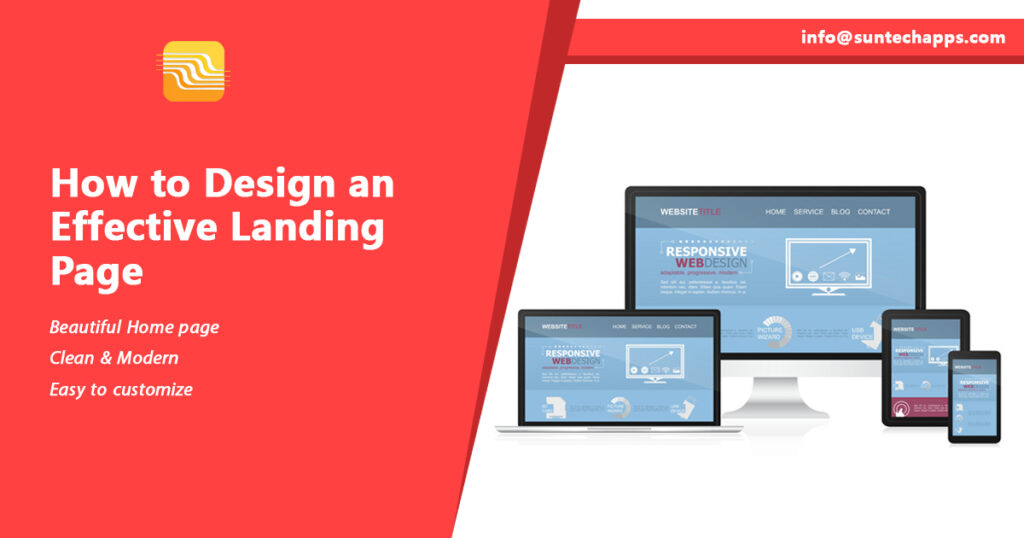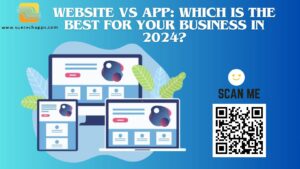How to design an effective Landing page
6 min read
website landing page
A landing page is an important part of the design development process and aims to entice visitors and drive them further down the conversion funnel. Landing page design needs to be flawless, and that’s what we’re going to talk about in this article.
Tips for creating an effective landing page

Keep to a simple layout
A good landing page design is minimalist and attractive, presenting information non-intrusively. To avoid sidetracking people with redundant visual elements, use a clean, simple design with plenty of white space that keeps people on your product and call to action. Choose a big font to make it easy for visitors to read and understand what your landing page is all about. Also, make sure your design doesn’t increase the page loading time.
Сheck the layout of your page at different resolutions to make sure that even people with older monitors will be able to see your heading and CTA without scrolling. And be sure to check how your layout is displayed on mobile devices.
Most visitors are likely to scroll down for more information, so don’t be afraid to add blocks that show when the page is scrolled.
Not so long ago, we released an application called Your Living-room Trainer that applies minimalist design and white space to make the landing page light and help users focus on what the service offers.
Provide discreet content
The content on your landing page must be to the point, highlighting your unique value proposition (UVP). The content you offer will depend on the type of product or service you’re selling. Remember that you have approximately eight seconds to convince users that your offer is worth pursuing. Excessive information can overwhelm visitors and make them leave the page immediately. Speak to your audience using plain language and tell how you can make their lives better.
Heading
The heading is the first text that your visitors see. It’s one of your first opportunities to influence your conversion rate. Use a heading that clearly states the biggest benefits that your product offers. In the heading, tell your visitors exactly what they can get on your landing page.
Subheading
The most effective landing pages indicate what’s being offered with the heading and use the subheading to further explain the offer and share the UVP. Subheadings may showcase whatever you’re offering in a new light. Some landing pages choose to push their value propositions to the heading and use the subheading to discuss the actual offers.
In one of our projects shown below, you can see how the subheading complements the heading. When users land on the page, they clearly understand what the service does and can click the call-to-action button right away.
Call to action
Provide captivating and clickable call-to-action (CTA) buttons that encourage visitors to purchase, sign up, request a demo, or do something else. The best option is to place CTAs at the top and bottom of the page so users don’t have to scroll all the way up to click. Or you can add a floating CTA button that’s always visible. Your CTA buttons will look nice if they change color or include animations to entertain visitors, adding to the overall impression your brand aims to create.
Double-check that your message in the CTA and the heading of the landing page correspond. If the heading reads differently than your call to action, it may lead to confusion, leaving visitors wondering whether the CTA is linked to the wrong page. Eliminate all confusion and make sure your text content reflects what you’ve promised in your call to action – and vice versa. If there’s a deliberate catch in your CTA (e.g. no free trial), you’ll lose your users’ trust.
Another project that we’ve worked on features a CTA button that’s textually and logically linked to the headings and subheadings. What’s more, it has a nice animation to engage visitors. Registered users can simply click the sign-up button in the upper right corner to proceed with the site.
Provide alluring imagery
Photos can enhance the way visitors engage with your offer just as text can. The visual reasoning skill enables humans to process and interpret meaning from what they see. Visual prompts can convey additional information to your visitors. Provide high-quality shots showing the best sides of your product or service. Make sure you hire a photographer who knows visual techniques to offer you photos that convert.
We’ve built an application for a luxury brand in which we added a background image of a watch on a man’s wrist to emphasize the chic nature of the company and create an impression of sophistication.
Create a trustworthy identity
Include all the trust signals you can to show visitors that your offer and brand are reliable. Most sites display social proof in the form of a list of customers, press mentions, usage statistics, and testimonials.
Good landing pages make abundant use of testimonials, trust marks, and badges. Testimonials are considered a classic trust signal that reassures visitors. Trust badges comprise logos of renowned brands you’ve worked with, endorsements and recognitions you’ve received, and groups and coalitions you’re a member of. All of these stamps of approval will give your customers more confidence in your brand and encourage them to move down the conversion funnel.
When showcasing logos as trust signals, keep them clean and focused. Make logos of square and display them in grayscale to keep the focus on your offer.
Perform A/B testing
It’s not enough to just make a landing page. You also need to test if it works well.To check whether your landing page can drive conversions, you need to perform A/B testing to collect valuable analytics on how users interact with the landing page.
What exactly to test depends on the origin of your traffic, your end goals that you can set in your testing tool. For example, you can test how often visitors clicked a button, watched a video, or send the lead form. Also, you can see how users landed on your page and what type of device they were using. To understand whether your landing page converts, you can use Google Analytics or Hotjar tool.
You can perform A/B testing on the following:
- Headings
- CTAs
- Images and graphics
- Buttons (look, text, and location)
- Trust signals
- Press quotes
- Placement of page elements (blocks)
- Navigation links
Adhere to mobile-first principles
To expand their reach, brands have adopted mobile-first strategies since half of all web activity comes from mobile. Your landing page should have a responsive design to help increase your conversion rate. An effective landing page should look great on mobile devices, load quickly, and be ultra clickable.
Encourage social sharing
Include social sharing icons so that your customers can spread the word about your brand. Social sharing icons become a sort of word-of-mouth promotion campaign. To avoid cluttering, use only buttons for social platforms that your target audience uses. Be sure to add an email forwarding option, since people still like to share things be email.
Use video to showcase the UVP
Video landing pages use embedded videos to help illustrate the unique value proposition. Video content is optional, but video can give a 360-degree view of your product or service in ways that text and images can’t.
People respond positively to emotional cues which encourage viewers to click.




